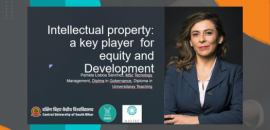You are here
Students from the European Community help a university researcher with a tsunami experiment
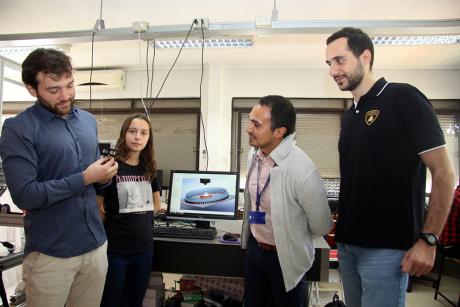
Dr. Leonardo Gordillo Zavaleta, academic within the Department of Physics, is currently studying the generation of ocean waves and tsunami experiments in the Innovation Laboratory, using a multi-action system. Interested in this initiative, two foreign exchange students -Francesco Paolo Contò, an Italian PhD student at Queen Mary University in England, and Narek Halsdorfer, a French undergraduate student at the École Nationale Supérieure de Mécanique des Microtechniques-, asked to join the research team.
Within the FONDECYT Initiation team led by Dr. Leonardo Gordillo Zavaleta, and in support of our institution's internationalization process, an Italian PhD student from Queen Mary University in England, Francesco Paolo Contò, and French undergraduate student, Narek Halsdorfer, from the École Nationale Supérieure de Mécanique des Microtechniques, participated in a research internship in the Department of Physics.
Their visit was framed within the project entitled “Multi-point programmed forcing of water beds: wave generation and tsunami in-lab experiments", currently in its second year of a total of three years of execution.
The initiative studies the generation of ocean waves and tsunami experiments in the innovation laboratory, using a multi-action system that considers the use of 64 low-cost actuators to increase the generation of long waves at the laboratory level, and which considers a limited number of studies at the global level.
“We must perform global scientific research with the contribution of professionals that have other perspectives, cultures and formation, as this helps our university's students involved in the project to generate networks and participate in future collaborations. The visiting students’ contribution has been important for broadening the scope of this project,” adds the lead researchers.
Students’ Experience
Leonardo Gordillo, a PhD in Physical Sciences, has been working in the area of fluid dynamics in association with the University of Santiago since 2017. His area of interest has led him to carry out international projects and internships in France and the United States, where he has laid the foundation for scientific relations with other academics.
So it was that academics from France and England recommended that their student travel to Chile and work on his project.
Within this context, Narek Halsdorfer joined the team already composed of Isis Vivanco and Lucas Martínez (5th year Physical Engineering students), Juan Marín (DICYT post-doctorate) and Alejandro Ibarra (PhD student in Materials Science).
During their internship, which will extend to mid-June of this year, they are studying how waves are generated within a canal when the ocean floor moves.
In this regard, Dr. Gordillo explains that, “for the most part, when you are studying structure fluids, for example, if you want to see if the hull of a boat can support the waves, it is necessary to generate waves in the assay testing area.”
However, he clarifies that it is hard to generate long waves in laboratories because the existing devices tend to be insufficient, therefore, the project tries to use a different low-cost design.
For this, Narek is working to implement and design the mechanical system of movement transmission.
They are currently creating the first prototypes for the canal, which considers a radius of 1.25 with a diameter of 2.30 and a width of 3 cm., generating a total device that is 6 meters long in a circle with 64 small motors placed at the bottom of the canal, which operate with this system.
On his scientific visit, the students highlights that, “it has been really interesting. I have been able to put all of my knowledge to practice and learn new things about electronics. I would like to do a more interdisciplinary specialization, and this is a great contribution. The education and environment are also very different. There is a lot more camaraderie and support from other students and professors, so I really like working here.”
On the other hand, the student Francesco Paolo Contò, who will be collaborating at the University of Santiago until the end of April, is working on his thesis under the guidance of Professor Rafael Castrejón-Pita, at Queen Mary University, and is planning to complete his PhD this year in Mechanical Engineering, with a specialization in Fluid Mechanics.
Francesco is currently studying fluid filaments. In practical terms, Dr. Gordillo is synthesizing the work of the PhD student, who will contribute to a new scientific publication at the inter-institutional level.
“For example, when honey is served, the stream drops and cuts off, and the honey rises back to the jar. This is called fluid filament retraction, which in this case is highly viscous. Francisco is performing experiments on this phenomenon in England with a system that consists of a syringe that he pushes to able to generate drops and filaments. Little work has been done to understand the theoretical part of the problem, and equations that clearly describe these types of systems,” comments the academic from our university community.
In this line, Dr. Gordillo and the student have worked on equations and how to reproduce the filament form, and they have already obtained results and are working on their scientific publication.
On his visit, the PhD student comments that, “coming here has been a very positive experience. I think the work done here is very similar to that in Italy. I have met people with good disposition and a highly collaborative atmosphere. I think Professor Gordillo is the best person I could have found to work on my dissertation with. It has been a very productive period, we have a lot of results to publish, and I am very happy to be here,” he concludes.
News
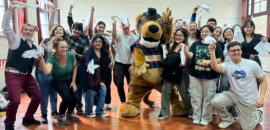 International students learn cueca with Usach Without Borders and Department of Cultures and Arts
International students learn cueca with Usach Without Borders and Department of Cultures and Arts
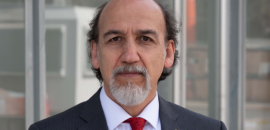 Rector Vidal to join the Governing Board of UNESCO's International Institute for Higher Education
Rector Vidal to join the Governing Board of UNESCO's International Institute for Higher Education
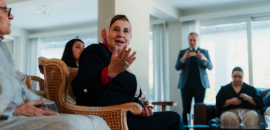 Students visited the Ambassador of Morocco to learn about the country's diplomatic work and culture
Students visited the Ambassador of Morocco to learn about the country's diplomatic work and culture



